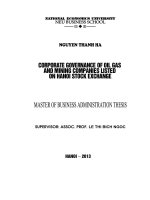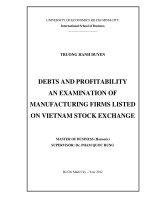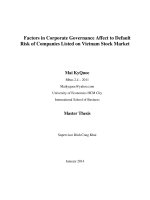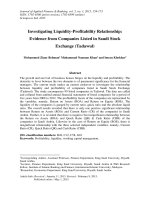corporate governance of oil gas and mining companies listed on hanoi stock exchange
Bạn đang xem bản rút gọn của tài liệu. Xem và tải ngay bản đầy đủ của tài liệu tại đây (1.09 MB, 104 trang )
National Economics University
Neu b us i nes s sc h o o l
Nguyen Thanh Ha
CORPORATE GOVERNANCE OF OIL GAS
AND MINING COMPANIES LISTED
ON HANOI STOCK EXCHANGE
Supervisor: Assoc. Prof. LE THI BICH NGOC
Hanoi – 2013
2
ACKNOWLEDGEMENTS
The successful completion of this dissertation would not have been possible
without the support and cooperation of others. I know that this project was not my
individual achievement but the result of many people to whom will be forever
grateful. Of those, I would like to express my sincere gratitude to my colleagues in
the Listing Management Department, who have been working with me in Hanoi
Stock Exchange. Their role was fundamental in the getting observation for the
questionnaire designed for the study and they contributed countless hours to the
completion of this project together with me.
Thanks to The Dean of NEU’s Business School – Assoc. Prof Tran Thi Van
Hoa, Dr. Le Thi Lan Huong who helping me a lot during the time of studying the
course in NEU’s Business School;
And especially thanks to the Committee members because of your sharing
expertise and guidance and each of you has assisted me in the review of my
proposal research and development of my thesis topic. I would like to express my
sincere thanks to Ms. Pham Thanh Hoa, and Ms. Doan Minh Hanh, program
coordinator who were always available and eager to lend a helping hand.
I would like to specially thank my supervisor Assoc. Prof. Le Thi Bich Ngoc
for her on-going support and for being flexible with my work schedule while she
corrected my thesis writing.
I am also thankful to Hanoi Stock Exchange giving me much support to
complete my dissertation.
Last but certainly not least, I must thank my family. To my parents, who
have always taught me the importance of education and encouraged me to continue
in my post graduate studies at National Economics University. Thanks to my
husband, who motivated me and shared with me when I felt so hard to keep my
MBA course going and provided confidence in my ability to accomplish whatever I
set out to do. To all of you, I am forever grateful.
2
3
TABLE OF CONTENT
3
4
ABBREVIATIONS
AA Articles of Association
ACGA Asian Corporate Governance Association
AFS Audited Financial Statements
AGM Annual General Meeting of Shareholders
AR Annual Report
ASEAN Association of South East Asian Nations
BOD Board of Directors, board
BOM Board of Management, management
CEO Chief Executive Officer
CG Corporate Governance
CGG Corporate Governance Guidance
CSR Corporate Social Responsibility
EGM Extraordinary General Meeting
ESG Environment, Social and Governance
FS Financial Statements
GMS General Meeting of Shareholders
HNX Hanoi Stock Exchange
HOSE Ho Chi Minh City Stock Exchange
IASB International Accounting Standards Board
ICGN International Corporate Governance Network
IFC International Finance Corporation
IFRS International Financial Reporting Standards
ISA International Standards on Auditing
MOF Ministry of Finance
N/A Not Applicable
OECD Organization for Economic Cooperation and Development
SB Supervisory Board
SSC State Securities Commission
SX Stock Exchange
VAS Vietnam Accounting Standards
4
5
LIST OF TABLES
LIST OF FIGURES
5
6
EXECUTIVE SUMMARY
This study was designed to investigate the corporate governance of 24 Oil gas
and mining companies because like many companies in Vietnam in general and which
being listed on Hanoi Stock Exchange in particular, the corporate governance is very
important for their long-term development and sustainability as well as market stability.
The objectives which covered in this study were to clarify the
areas/categories of corporate governance in 24 reviewed companies, to analyze their
current corporate governance and to give recommendations for improving the
corporate governance in these 24 companies.
The scope targeted in this study included 24 companies listed on
Hanoi Stock Exchange. The companies are specializing in oil, gas and
mining field and the corporate governance in 24 companies is very
outstanding. The time for this study was 2012.The data collection in this
study was gathered through the designed questionnaires. The questionnaires
were to examine the aspects identified in the literature and meant to fulfill
the objectives pre-determined. Secondary data is collected from the
companies’ annual reports, Charter of company, Audited Financial
Statements, website, AGM, CG guidelines, CG report, CG policy, special
reports or the companies’ other previous studies (if any) which mentioning
about the corporate governance or statistic of violating to disclose
information by those oil and mining companies in 2012 done by HNX. The
secondary data reviewed and prepared the platform for the formulation of
questionnaire.
By observing the possible responses for the 59 questions in the
questionnaire, data was collected. For the purpose of the study, 59 questions which
set up based on Enterprise Law in 2005, Circular No. 121 and Circular No. 52 and
OECD’s recommendations were observed on 5 areas/categories (OECD’s principles
of corporate governance). After analyzing, the strong point and weak point of each
area/category were discovered and clarified.
6
7
With the findings of the study, it was known that which weak points in 5
areas/categories should be changed or improved to enhance corporate governance in
the 24 oil gas and mining companies and which strong points in 5 areas/categories
should retain to maintain their current corporate governance.
7
8
CHAPTER 1: INTRODUCTION
1.1 Rationale
Corporate governance is a reasonably new concept to Vietnam, introduced
largely as a result of changes to the Law on Enterprise in 2005 and with the
introduction of corporate governance Regulation for listed companies in 2007. The
purpose of the corporate governance Regulation is to implement the “best
international practice on corporate management suitable to the conditions of
Vietnam to ensure a stable development of stock market and a transparent economy
in Vietnam”. Improvements in corporate governance can serve a number of public
policy objectives such as enhancing market stability, increasing investor confidence
and trust, encouraging investment into Vietnam from foreign sources and reducing
the cost of capital for companies.
Recently, the overall corporate governance performance of reviewed
companies indicates efforts to implement elements of good corporate governance
(refer to the report of corporate governance scorecard in 2009 done by
International Finance Corporation (IFC). However, the results of the review would
indicate that corporate governance in Vietnam is at the rudimentary stage and ripe
for improvement. Corporate governance developments seem to have been led by
investment in regulatory and legislative developments – a rule driven “top down”
approach.
It should be noted that besides as lack of awareness, corporate governance
practices in Vietnamese companies are more driven by compliance with regulatory
requirements than commitment to a higher practice of sound governance. Therefore,
issues which are not provided for in current laws and regulations, such as ones
relating to external auditors (independence and GMS (General meeting of
shareholders of AGM) attendance… ) or stakeholders’ roles, have not been given
8
9
sufficient attention by the companies. Consequently companies’ scores in these
areas are low.
Oil Gas & Mining stocks have always been prioritized in investors’ portfolio
not only because of the amazing business performance but also because of the
crucial role of this industry in the long-term development strategy of Vietnam.
Currently, there are 24 Oil Gas & Mining companies listed on HNX. Oil Gas
& mining stocks make up 20% of the total charter capital of listed organizations on
the exchange and rank 3
rd
in scale of charter capital, behind Banking, Real Estate
and Food & Beverage. It does mean that Oil and Mining stocks have a big attraction
in the market.
All of Oil Gas and Mining companies have been equitized and converted
in to joint stock company in which Petrol Vietnam Oil and Mining Group is a
state-owned company holding a majority interest of 51% and exercises its
control via the GMS and the director appointed by the State to the company’s
Board of Directors. While holding structures can serve legitimate purposes,
cross-shareholdings and lack of transparency have the tendency to create opaque
ownership structures. This could make a company difficult to understand for
shareholders and investor. Such structures could be used to expropriate and
circumvent the rights of individual shareholders. Poor consolidates accounting,
or even the absence thereof, is a further CG issue that has yet to be tackled.
Moreover, according to IFC’s report – the international financial organization
who did their corporate governance review in 2009 of which the 100 largest
publicly listed companies on Hanoi Stock Exchange (HNX) and Ho Chi Minh
Stock Exchange (HOSE) being selected, the Oil and Mining companies have the
lowest score of corporate governance by 39,1% amongst 09 industry sectors
being selected by IFC for that review.
Based on the above mentioned issues, this study is carried out with the aim
of exploring the corporate governance status in the Oil Gas and Mining companies
9
10
and also helping Oil Gas and Mining companies to understand the message that
sound CG is good for their business and it can positively affect the profitability and
market performance of them.
1.2 Research Objectives
The study covers three following objectives:
1) Clarify the major categories to evaluate corporate governance of Oil Gas
and Mining Companies (The major categories are rights of shareholders, equitable
treatment of shareholders, role of stakeholders in corporate governance, disclosure
and transparency and the responsibilities of the board).
2) Assessing the current corporate governance of Oil Gas and Mining
Companies
3) Give recommendations to improve corporate governance of Oil Gas and
Mining Companies
1.3. Research Questions
To achieve the objectives targeted by the study, some questions must be
answered:
1. What are the major categories of corporate governance? And how are they in Oil
Gas and Mining Companies?
2. How is the corporate governance in Oil Gas and Mining Companies at present?
3. What should be done to improve the corporate governance in Oil Gas and Mining
Companies?
10
11
1.4 Research methodology and data
This part of writing will embrace the preview for method of data
collection in orderly manners in the aspects of how the data were collected,
where the data is to be sourced and how to design and implement the
questionnaires. The research methodology serves to explain and achieve the
objectives mentioned in the item.
11
Problem identification
Generate objectives of study and scope of study
Literature review
Developing questionaires and carry out reviewing suitable observations by the questionaires
Checking and sorting of data achieved in the questionaires
Data analysis
Result and discussion
Conclusions and recommendations
12
1.4.1 Research process:
Note: If the data analysis step is not clear or not enough clarified for
discussion, it is possible to do re-analyzing data.
1.4.2 Secondary data collection
Data collection is considered as the crucial stage in gathering all
required information form the fundamental in achieving main objectives of
the study.
Secondary data is collected from the companies’ annual reports,
Charter of company, Audited Financial Statements, website, AGM, CG
guidelines, CG report, CG policy, special reports or the companies’ other
12
13
previous studies (if any) which mentioning about the corporate governance
or statistic of violating to disclose information by those oil and mining
companies in 2012 done by HNX. The secondary data reviewed and
prepared the platform for the formulation of questionnaire. The
questionnaires are designed based on the OECD’s good corporate
governance principles and regulations in Circular no. 121 (issued by MOF
regarding the corporate governance applied for the public
organizations/companies) and Circular no. 52 (issued by MOF regarding
their guidance of disclosing information in stock market) as well as
Enterprise Law in 2005.
The data collection in this study is gathered through designed questionnaires.
The questionnaires to examine the aspects identified in the literature and meant to
fulfill the objectives pre-determined.
During the questionnaire’s preparation stage – questionnaires are designed
and are aimed to enable more objective responses rather than superfluous views that
contained no concrete substance or justification. The questionnaires are designed in
order to obtain a wider range of views towards the study. They are designed in such
a way that simple and straightforward.
The questionnaire structure: the questionnaires are designed to support
collecting data. They consist of 59 questions which are set up based on Enterprise Law
in 2005, Circular No. 121 and Circular No. 52 and OECD’s princiles which are
detaited in the following chapter 4 of the thesis.
1.4.3 Data analysis
The data are pre-processed using the Microsoft Excel for Microsoft
Professional Windows XP.
13
14
1.4.4 Scope of research
a) This study concentrates in 24 Oil gas and Mining companies listed on Hanoi
Stock Exchange
b) The study will focus on corporate governance of Oil Gas and Mining
companies.
c) Time: 2012
d) Objects: 24 Oil and Mining Companies.
1.4.5 Structure of thesis
The thesis is organized into the following chapters:
a) Chapter 1: Introduction
b) Chapter 2: Theoretical background on corporate governance
c) Chapter 3: Oil and Mining companies and its current corporate
governance practices
d) Chapter 4: Assessing current corporate governance practices in Oil Gas
and Mining Companies.
e) Chapter 5: Conclusions and recommendations for Oil and Mining
Companies to improve their corporate governance.
14
15
15
16
CHAPTER 2
THEORETICAL FRAMEWORK ON CORPORATE
GOVERNANCE
2.1 Nature of corporate governance
2.1.1 Definitions of corporate governance
There is no single definition if corporate governance that can be applied to
all situations and jurisdictions. The various definitions that exist today largely
depend on the institution or author, country and legal tradition.
International Finance Corporation (IFC) defines corporate governance as
“the structures and processes for the direction and control of companies.” The
Organization for Economic Cooperation and Development (OECD), which in 1999
published its Principles of Corporate Governance, offers a more detailed definition
of corporate governance as:
“The internal means by which corporations are operated and controlled
[….], which involve a set of relationships between a company’s management, its
board, its shareholders and other stakeholders. Corporate governance also
provides the structure through which the objectives of the companies are set, the
means of attaining those objectives and monitoring performance are determined.
Good corporate governance should provide proper incentives for the board and
management to pursue objectives that are in the interests of the company and
shareholders, and should facilitate effective monitoring; thereby encouraging firms
to use resources more efficiently”.
Most definitions that center of a company itself (an internal perspective) do,
however, have certain elements in common, which can be summarized as follows:
16
17
- Corporate governance is a system of relationships, defined by structures
and processes.
- These relationships may involve parties with different and sometimes
contrasting interests.
- All parties are involved in the direction and control of the company.
- All this is done to properly distribute rights and responsibilities and thus
increase long term shareholder value.
2.1.2 Brief history of Corporate Governance
Corporate governance systems have evolved over centuries, often in
response to corporate failures or systemic crises. The first well-documented failure
of Governance was South Sea Bubble in the 1700s, which revolutionized business
laws and practices in England. Similarly, much of the securities law in the U.S was
put in place following the stock market crash of 1929. There has been no shortage
of other crises, such as the secondary banking crisis of the 1970s in the U.K, the
U.S savings and loan debacle of the 1980s, the 1998 financial crisis in Russian, the
1997-1998 financial crisis in Asia (especially in Indonesia, South Korea, and
Thailand) and the current global financial crisis which started in 2008 and has not
shown signs of ending at the time of this book. The history of corporate governance
has also been punctuated by a series of well-known company failures. The early
1990s saw the Maxwell Group raid the pension fund of the Mirror Group of
newspapers and witnessed the collapse of Barings Bank. The new century likewise
opened with the spectacular collapse of Enron in the U.S, the near-bankruptcy of
Vivendi Universal in France, the scandal at Parmalat in Italy, the trading fraud
which Societe General and the most recent Madoff multi-billion dollar Ponzischeme
make other scandals pale in comparison. Each of these corporate failures, often
occurring as a result of incompetence or outright fraud, was swiftly met by new
17
Figure 2.1: Some highlights in the history of corporate governance, largely from the western world and Vietnam.
1600s: The East India Company introduces a Court of Directors, separating ownership and control (U.K., the Netherlands).
1776: Adam Smith in the “Wealth of Nations” warns of weak controls over and incentives for management (U.K.)
1844: First Joint Stock Company Act (U.K.)
1931: Berle and Means publishes its seminal work “The Modern Corporation and Private Property” (U.S.)
1933/34: The Securities Act of 1933 is the first act to regulate the securities markets, notably registration disclosure. The 1934 Act delegates’ responsibility for enforcement to the SEC (U.S.);
1968: The EU adopts its first company law directive (EU)
1987: The Treadway Commission reports on fraudulent financial reporting, confirming the role and status of audit committees and develops a framework for internal control, or COSO, published in 1992 (U.S.)
1987: The National Assembly of Vietnam adopts the Foreign Investment Law
1990: The National Assembly of Vietnam adopts the Company Law and the Law on Private Enterprises
Early 1990s: Polly Peck (£1.3 billion in losses), BCCI and Maxwell (£480 million) business empires collapse, calling for improved corporate governance practices to protect investors (U.K.)
1992: The Cadbury Committee publishes the first code on corporate governance and in 1993; companies listed on the U.K.’s stock exchanges are required to disclose governance on a “comply or explain” basis (U.K.)
1994: Publication of the King Report (S. Africa)
1994 & 1995: Rutteman (on Internal Controls and Financial Reporting), Greenbury (on Executive Remuneration), and Hampel (on Corporate Governance) reports are published (U.K.)
1995: Publication of the Vienot Report (France)
1995: The National Assembly of Vietnam adopts the Law on SOEs
1996: Publication of the Peters Report (the Netherlands)
1996: The National Assembly of Vietnam adopts the new Foreign Investment Law, which replaces the Foreign Investment Law of 1987
1997: The National Assembly of Vietnam adopts the Law on State Bank and the Law on Credit Institutions
1998: Publication of the Combined Code (U.K.)
1999: OECD publishes the first international benchmark, the OECD Principles of Corporate Governance
1999: Publication of the Turnbull guidance on internal controls (U.K.)
1999: The National Assembly of Vietnam adopts the Law on Enterprises, which replaces the Company Law and the Law on Private Enterprises
2000: The National Assembly of Vietnam amends the Foreign Investment Law of 1996
2000: The National Assembly of Vietnam adopts the Law on Insurance Business
2001: Enron Corporation, then the seventh largest listed company in the U.S., declares bankruptcy (U.S.)
2001: The Lamfalussy Report on the Regulation of European Securities Markets (EU) is published
2002: The Government Office of Vietnam issues the first Model Charter of listed companies16
2002: Publication of the German Corporate Governance Code (Germany)
2002: The Enron collapse and other corporate scandals lead to the Sarbanes- Oxley Act (U.S.); the Winter Report on company law reform in Europe is published (EU)
2003: The Higgs Report on non-executive directors are published (U.K.)
2003: The National Assembly of Vietnam adopts the new Law on SOEs to replace the Law on SOEs of 1995
2004: The Parmalat scandal shakes Italy, with possible EU-wide repercussions (EU)
2004: The National Assembly of Vietnam adopts the Law on Competition
2004: The National Assembly of Vietnam amends the Law on State Bank of 1997 and the Law on Credit Institutions of 1997
2005: The National Assembly of Vietnam adopts the new Law on Enterprises and the Law on Investment, which replaces (i) the Foreign Investment Law, (ii) the Law on Enterprises of 1999, and (iii) the Law on SOE
2006: The National Assembly of Vietnam adopts the Law on Securities
2007: The MOF of Vietnam adopts the CG Regulations and the Model Charter.
2010: The MOF of Vietnam adopts Circular 09/2010/TT-BTC governing the disclosure of information on the securities market.
2010: The National Assembly of Vietnam adopts the new Law on State Bank and new Law on Credit Institutions.
18
governance frameworks, most notably the many national corporate governance
codes, the Sarbanes – Oxley Act and the current trend towards imposing stricter
regulatory oversight on banking and financial activities in various countries.
18
19
It is fair to say that, although there is still plenty of room for improvement,
the legal and regulatory framework on corporate governance has changed and
improved dramatically in recent years. The adoption of (1) the Law on Foreign
19
20
Investment in 1987, its amendments in 2000 and its later unification with the Law
on Enterprises and Law on Investment in 2005, (ii) the Law on Enterprise in 1999,
and its amendments in 2005, (iii) the law on State Bank in 1997; the Law on Credit
Institutions of 1997 and the amendments to both laws in 2003 and 2004,
respectively and the replacements of both laws in June 2010, (iv) the Law on
Insurance Business in 2000 and (v) the Competition Law in 2004 and (vi) the Law
on Securities in 2006, are but some examples of many positive changes to the legal
and regulatory framework. The adoption of the CG Regulations, although not heavy
in detail, certainly must be hailed as another positive step for Vietnam corporate
governance, providing the first ever set of corporate governance guidelines for
companies in Vietnam, in general and listed companies, in particular.
2.2.3 Benefits of corporate governance
Good corporate governance is important on a number of different levels. At
the company level, well-governed companies tend to have better and cheaper access
to capital, and tend to outperform their poorly governed peers over the long-term.
Companies that insist upon the highest standards of governance reduce many of the
risks inherent to an investment in a company. Companies that actively promote
robust corporate governance practices need key employees who are willing and able
to devise and implement good corporate governance policies. These companies will
generally value and compensate such employees more than their competitors that
are unaware of, or ignore, the benefits of these policies and practices. Such
companies, in turn, tend to attract more investors who are willing to provide capital
at lower cost.
Generally, well-governed companies are better contributors to the national
economy and society. They tend to be healthier companies that add more value to
shareholders, workers, communities, and countries in contrast with poorly governed
companies that may cause job and pension losses, and even undermine confidence
in securities markets.
20
Improved
Operational
Efficiency
Access to Capital Markets
Lower Cost of Capital
Better Reputation of the Company, its Directors and Managers
21
Source: IFC, March 2004
Figure 2.2: Potential Benefits of Corporate Governance
a. Stimulating performance and improving operational efficiency:
An improvement in the company’s governance practices leads to an
improvement in the accountability system, minimizing the risk of fraud or self-
dealing by the company’s officers. Accountable behavior, combined with effective
risk management and internal controls, can bring potential problems to the forefront
before a full-blown crisis occurs. Corporate governance improves the management
and oversight of executive performance, for example by linking executive
remuneration to the company’s financial results. This creates favorable conditions
not only for planning the smooth succession and continuity of the company’s
executives, but also for sustaining the company’s long-term development.
Adherence to good corporate governance standards also helps to improve the
decision-making process. For example, managers, directors and shareholders are all
likely to make more informed, quicker and better decisions when the company’s
governance structure allows them to clearly understand their respective roles and
responsibilities, as well as when communication processes are regulated in an
effective manner. This, in turn, should significantly enhance the efficiency of the
21
22
financial and business operations of the company at all levels. High quality
corporate governance streamlines all the company’s business processes, and this
leads to better operating performance and lower capital expenditures, which, in turn,
may contribute to the growth of sales and profits with a simultaneous decrease in
capital expenditures and requirements.
b. Improving access to the capital markets
Corporate governance practices can determine the ease with which
companies are able to access capital markets. Well-governed firms are perceived as
investor friendly, providing greater confidence in their ability to generate returns
without violating shareholder rights.
Good corporate governance is based on the principles of accessibility,
accuracy, completeness, efficiency, timeliness and transparency of information at
all levels. With the enhancement of transparency in a company, investors benefit
from being provided with an opportunity to gain insight into the company’s
business operations and financial data. Even if the information disclosed by the
company is negative, shareholders will benefit from the decreased risk of
uncertainty.
Of particular note are the observable, if recent trends among investors to
include corporate governance practices as a key decision-making criterion in
investment decisions. The better the corporate governance structure and practices,
the more likely that assets are being used in the interest of shareholders and not
being tunneled or otherwise misused by managers.
c. Lowering the company’s cost of capital and raising the value of Assets
Companies committed to high standards of corporate governance are
typically successful in obtaining reduced costs when incurring debt and
financing for operations. As a result, they are able to decrease their capital costs.
The cost of capital depends upon the level of risk assigned to the company by
investors - the higher the risk, the higher the cost of capital. These risks include
22
23
investor rights violations. If investor rights are adequately protected, the cost of
equity and debt capital may decrease. It should be noted that investors providing
debt capital, i.e. creditors, have recently tended to include a company’s corporate
governance practices (for example, a transparent ownership structure and
appropriate financial reporting) as a key criterion in their investment decision-
making process. Thus, the implementation of a good corporate governance
system should ultimately result in the company paying lower interest rates and
receiving longer maturity on loans and credits.
This holds particularly true in countries such as Vietnam where the legal
framework is relatively new and still being tested, and where courts do not always
provide investors with effective recourse when their rights are violated. This means
that even modest improvements in corporate governance relative to other companies
can make a large difference for investors and decrease the cost of capital.
d. Building a better reputation
In today’s business environment, reputation has become a key element of a
company’s goodwill. A company’s reputation and image effectively constitute an
integral, if intangible, part of its assets. Good corporate governance practices
contribute to and improve a company’s reputation. Thus, those companies that
respect the rights of shareholders and creditors, and ensure financial transparency
and accountability, will be regarded as being an ardent advocate of investors’
interests. As a result, such companies will enjoy more public confidence and
goodwill.
This public confidence and goodwill can lead to greater trust in the company
and its products, which in turn may lead to higher sales and, ultimately, profits. A
company’s positive image or goodwill is known to play a significant role in the
valuation of a company. Goodwill in accounting terms is the amount that the
purchase price exceeds the fair value of the acquired company’s assets. It is the
premium one company pays to buy another.
23
24
2.2 Theories of corporate governance:
There are several well-developed theoretical perspectives that are available
to researchers to aid them in exploring the issues of corporate governance. These
theories include: managerial hegemony theory, agency theory, stewardship theory,
stakeholder theory and resource dependence theory.
2.2.1 International theories:
1 a. The stewardship theory:
It suggests that management and board members in an organization will be
motivated by some larger force than the desire for personal wealth. Drawing on
organizational psychology, it suggests that self-esteem and fulfillment loom large in
their decision making, as had suggested in Maslow’s hierarchy of needs.
Stewardship Theory has its roots from psychology and sociology and its origin is
defined by Davis, Schoorman and Donaldson (1997), the stewardshop theory. This
theory may help to explain why people might still want to serve on boards of
director of public companies, despite the risk of prosecution under local acts or
costly shareholder lawsuits so common in the litigious western world. However,
some directors see their roles as being stewards of particular interest group only.
When a major shareholder secures a seat on the board, its appointed director will
understandably be tied to that shareholder’s aims, whatever company law might
say.
2 b. Stakeholder theory:
The origin of the Stakeholder theory of corporate governance can be traced
to Freeman (1994) who defines stakeholders as “any group or individual who can
affect, or is affected by, the achievement of a corporation’s purpose”. This evolved,
in part, as a result of the recognition of the complexity of strategy and the growing
recognition that, unlike as thought previously, a company was not just a production
system where strategy was focused primarily on products and the means to produce
them. The focus of the stakeholder theory is articulated in two core questions
24
25
formulated by Freeman (1994). The first question is what is the purpose of the firm?
And secondly, the stakeholder theory asks, what responsibility does the
management have to stakeholders?
3 c. Agency theory:
The debate about corporate governance is typically traced way back to the
early 1930s and Adolf Berle and Gardiner Means (1930s), the Modern Corporation
and Private Property. Adolf Berle and Gardiner Means noted that with the
separation of ownership and control, and the wide dispersion of ownership, there
was effectively no check upon the executive autonomy of corporate managers. In
the 1970s these ideas were further refined in what has come to be known as Agency
Theory. In a series of now classic articles writers such as Jenesen and Meckling,
Fama, and Alchian and Demsetz (1970s) offered a variety of explanations of the
dilemmas faced by the 'principal' who employs an 'agent' to act on his or her behalf.
As applied to corporate governance the theory suggests a fundamental problem for
absent or distant owners/shareholders who employ professional executives to act on
their behalf. In line with neo-classical economics, the root assumption informing
this theory is that the agent is likely to be self-interested and opportunistic.
Agency theory or agency relationship is the theory which looks at the
relationship between the owners of the company in the form of shareholders (equity
investors) and those have been given responsibility to take charge of the
management of the company in the form of directors. Agency theory is one of the
key concepts underlying the importance of corporate governance, which has taken
prominent role in business activities in the last few decades. It has its roots in
almost every aspect of business activities and plays a very significant role in
decision-making by directors (both executive and non-executive directors).
Agency theory is equally important as corporate governance, since it forms
the backbone of any successful corporate governance policies and regulations, (get
the agency theory framework right and the corporate governance principles will
25









